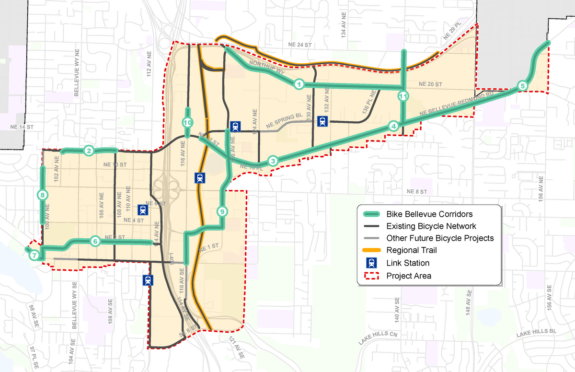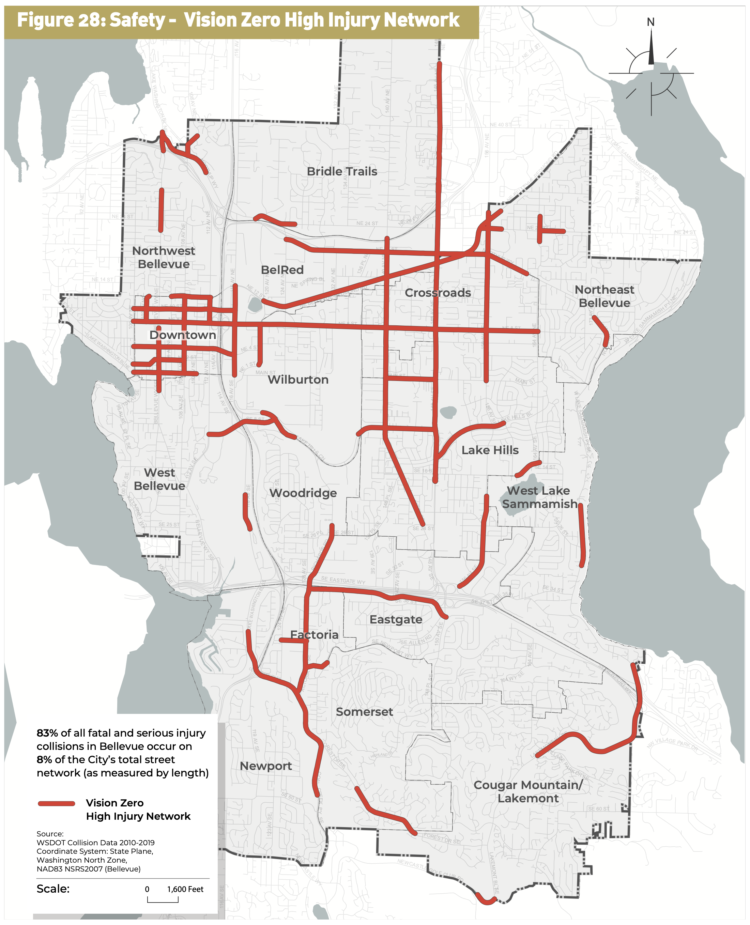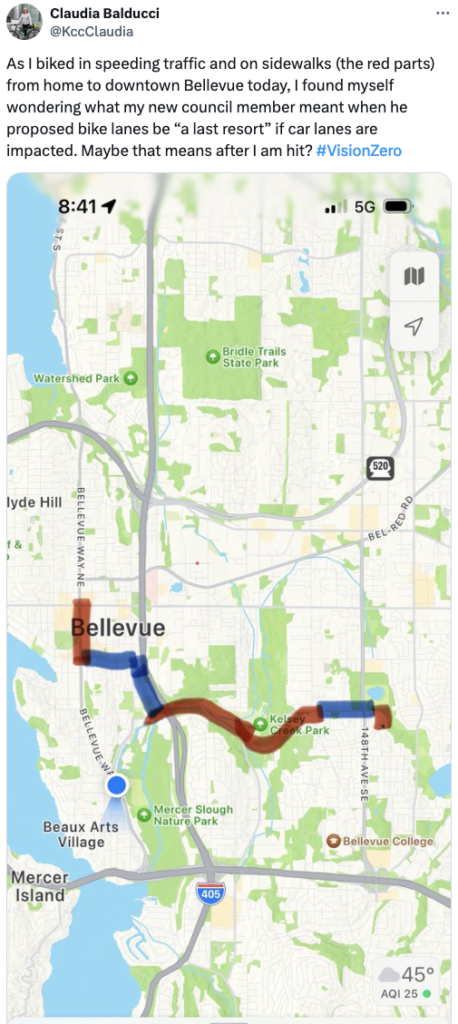Bellevue Council torches their Vision Zero plan, refuses to stand against unfounded attacks on city staff
The news out of the Bellevue City Council this week was extremely disappointing. The council decided to backtrack on their Vision Zero commitment and all but toss out most of the Bike Bellevue network that was developed over a period of years following significant public outreach and study. In the process, they also left their city's staff exposed to further personal and professional attacks (see section 2).
The ambitious Bike Bellevue plan may be doomed The Bellevue City Council has decided that most of these streets should remain dangerous.
The Bellevue City Council has decided that most of these streets should remain dangerous.Bellevue's City Council voted to only consider reallocating general purpose travel lanes as a last resort," Ryan Packer reported for the Urbanist. During the meeting (the video is posted below), Councilmembers kept repeating over and over that they were opposed to any projects that would remove travel lanes." An attempt to pass a motion banning the removal of travel lanes failed 2-5 (Councilmembers Jared Nieuwenhuis and Conrad Lee voted in favor), but a motion to consider projects that would remove general purpose travel lanes only as a last resort" passed 6-1 (Mayor Lynne Robinson opposed). Several councilmembers, including Dave Hamilton, made it quite clear that they don't see themselves ever supporting any projects that would remove travel lanes. I can't imagine ever thinking it's a good idea," he said.
This vote, however, is in direct and clear conflict with essentially every official city transportation policy document, including (but probably not limited to) the 2020 Vision Zero Strategic Plan, 2023 Vision Zero Action Plan, 2022 Mobility Implementation Plan, and 2023 Downtown Mobility Study. All of these documents state that Bellevue has adopted a safe systems approach" to traffic safety, which explicitly relies on redesigning dangerous streets to reduce speeding and improve safety for all road users.
Today, we know that one of the most effective approaches to improving safety on streets is to use road reconfigurations...to narrow travel lanes, reduce the number of vehicle lanes, or both, while providing space for bicyclists and pedestrians," states the Bellevue Vision Zero Strategic Plan (page 25, PDF), which the City Council adopted in 2020.
The Bellevue Transportation Commission examined the attributes of the Safe Systems approach and concurred that Safe People, Safe Streets, Safe Speeds, Safe Vehicles-as well as the supporting elements of leadership, culture, partnerships and data-all help contribute to reducing the frequency and severity of crashes," states the city's 2023 Vision Zero Action Plan (page 4, PDF). This holistic approach accepts that people will make mistakes and that crashes will continue to occur, but it aims to ensure these do not result in serious injuries or fatalities."
The core misunderstanding throughout the entire council meeting was that more lanes does not equate to better traffic, especially in an urban or even suburban environment. That is a simplistic and outdated way of thinking about how streets work. In reality, people and their movements are much more complex, and streets that are flexible are more efficient than streets that prioritize straight-ahead movement over every other movement. People are not Hot Wheels following the same track from A to B. Some people need to turn left and some people need to cross the street, and some people are walking, and some people are biking, and some people are in wheelchairs, and some people have strollers, and some people are making deliveries, and having too many travel lanes makes these non-straight-through movements slower and much more dangerous.
For example, this is why NE 65th Street in Seattle can now move 5% more vehicles after SDOT reallocated nearly 25% of the street space to create protected bike lanes and safer crosswalks (study PDF). People can turn left now, which makes it a better street to drive on. They reduced speeding by up to 75%, reduced collisions by 63%, and eliminated serious injuries and deaths. And they did all this while moving more people in cars and dramatically more people biking, walking and rolling. This is not a last resort" solution, it's a common sense solution that is backed by data rather than feelings.
Councilmember Lee spoke against getting rid of car lanes for the benefit of bicyclists because one is suffering from the other." But dangerous streets are bad for people in cars, too. Safe streets are not zero-sum calculations where any gain by one group must come at an equal loss from another. This isn't a sport, it's a city. Complete streets are about making streets that work for everyone.
Bellevue's streets are not simply pipes for cars," as former SDOT Director Peter Hahn used to phrase it. They are part of the community. But the conversation during the council meeting never included any discussion of modern street design. The whole meeting could have gone so differently if only they had invited an expert in safe streets design to present about how modern safe streets work. But they didn't. They irresponsibly scoffed at and dismissed the most effective and affordable method of improving safety on Bellevue's streets, and then sent the city's Transportation Commission misguided direction. It was depressing to watch.
I hope the Bellevue City Council takes the time to review their own Vision Zero plans and consult with safe streets experts (rather than politically-powerful developers), because there's really good stuff in them such as this enlightening and relevant section about the history of street design in Bellevue (page 36 of the Bellevue Vision Zero Strategic Plan, PDF):
Many of Bellevue's roads were designed and built in the 1950s and 1960s, in accordance with the standards and road building practices of the day. At the time, the priority for roadway design was to quickly and efficiently move cars. Reflecting the modernist culture and the automobile-oriented development patterns of that era-and the expectation that people would drive for all their travel needs-these roadways often lacked sidewalks and featured few pedestrian crossings. Bicycle facilities were non-existent, as the utilitarian cycling culture that influenced other cities earlier in the century had by mid-century been replaced with the notion that cycling was only a recreational activity. Since then, much has changed. Today, dependence on the automobile is being balanced with infrastructure investments that facilitate safe mobility by all modes along networks of Complete Streets. Complete Streets make it safe, comfortable, and convenient to walk, bike, and roll to get to work, school, shops, services, parks, transit, and anywhere else people want to go. Bellevue's commitment to Complete Streets is in alignment with the Safe Systems approach to Vision Zero.
Councilmember Janice Zahn was an exception during the meeting. As a former member of the Bellevue Transportation Commission, Zahn spoke up about the importance of Vision Zero and the need to address safety on the city's most dangerous streets.
We committed to Vision Zero eight years ago as a city and developed the high injury network map," she said, referring to a map that highlights the streets where the vast majority of fatal and serious injury collisions occur. She also sounded the alarm that backing away from these high injury streets could put grant funding in jeopardy. In 2020, we committed to a safe system approach where a big part of what we've been doing the last couple years is actually pursuing DOT grants for safety on our roads," she said. The $2.7 million grant that we got actually includes a map that shows the high injury network and our bike network. So I'm really trying to understand if we're going to re-evaluate these corridors but we've actually already published information that we're pursuing grand funding, does that create any issues for us if we now decide that these aren't the corridors that we want to pursue."
 83% of fatal and serious injury collisions in Bellevue happen on just 8% of their streets. From the Vision Zero Strategic Plan. Many of these streets are included in the Bike Bellevue plan, though the Council signaled a desire to remove them.
83% of fatal and serious injury collisions in Bellevue happen on just 8% of their streets. From the Vision Zero Strategic Plan. Many of these streets are included in the Bike Bellevue plan, though the Council signaled a desire to remove them.Zahn also noted that Bellevue itself has already repurposed travel lanes to build protected bike lanes, so the city could evaluate how those streets are now functioning. Are we finding more issues related to travel time in those three areas?" she asked. How much of a delay would we find to be acceptable if we're actually creating better safety on our roads?"
In addition, there is plenty of data out there from places all over the country who have completed safe streets projects, including places that are not on the other side of the lake. Many cities around the country have already implemented this, and they have data themselves," said Zahn. We have some data ourselves on our roads."
She also pushed back against taking out any street that is in the high injury network map. I would have a hard time, thinking about transportation safety, taking corridors off that have injuries," she said. Even if it's hard to do because it's a high injury network, we need to lean in and not take it out."
 The Bellevue Council's actions caught the attention of King County Councilmember (and former Bellevue Councilmember) Claudia Balducci.
The Bellevue Council's actions caught the attention of King County Councilmember (and former Bellevue Councilmember) Claudia Balducci.Unfortunately, making Bike Bellevue stronger was never on the table. The decision was made before the meeting even began that they were going to hack away at it. The meeting's debate was merely about where to slash and how deep.
In the end, Bike Bellevue survived the most explicit efforts to gut it, but just barely. City staff and the Transportation Commission are still working to come up with priority recommendations to send back to the council for future debate and potential adoption. But the Council this week sent signals that they most likely will not approve funding for projects on the streets that need safety improvements most, and they likely won't approve plans designed according to best practices for safe streets. Their misguided direction will hamper both the planning and engineering work, paving the way for an ineffective, incomplete and insufficient bike network for their city.
I urge the council to reconsider their direction.
Bike Bellevue has been developed through a years-long public outreach process. It is a strong plan that followed every possible step in the public policy development process. It is based on data-yes, real data-and best practices for modern street design. Why would the people of Bellevue engage in another of your public processes if you throw out their work like this? The signal to the public is that Bellevue never intended to follow through on making streets safer. I don't want to believe that this is true, but after watching the meeting from this week, I don't know what other conclusion there is.
The Bellevue City Council has invited more attacks on city staffBut Bike Bellevue aside, the Council's decision to reward personal attacks on a city staffer is inexcusably cowardly. As we reported previously, a Bellevue resident accused Bike Bellevue staffer Franz Loewenherz of unethical behavior related to public outreach for the Bike Bellevue program. A city-ordered investigation into the allegation fully and completely cleared Loewenherz of all wrongdoing without caveat. The allegations were bogus, and the investigation instead highlighted that even under intense scrutiny the Bike Bellevue project was developed by the book and with integrity. We wrote that it would be appropriate for city leaders to make a public show of support for Loewenherz, who I imagine has had a very stressful couple months because of this."
Instead, they have done the opposite. The City of Bellevue removed him from the Bike Bellevue program and refuses to reinstate him, and then the Council this week all but dismantled it. They did exactly what the bogus ethics complaint was seeking. Councilmember Hamilton even parroted some of the ethic complaint's points during the meeting.
I think the issue I've seen that there has been some preferential treatment given to a subset of stakeholders I think was a mistake," he said, and I think going back to the Transportation Commission is a way to correct that lapse."
Councilmember Hamilton, read your city's report (PDF) please. I am begging you. Or at least read our summary. Investigators looked into these allegations at excruciating length and determined that the actions were consistent with the project principle" that the Bellevue City Council directed. The witnesses interviewed consistently reported that the public engagement process for Bike Bellevue has been robust" and significantly more extensive than any other Transportation project they had previously worked on," the investigation found. All witnesses emphasized that the goal of the Bike Bellevue community engagement plan was to disseminate information about the project as widely as possible to get feedback from a variety of sources and perspectives, which included neighborhood groups, businesses, as well as likely users of the bike facilities." This is all in the report. The evidence does not support the conclusion that emailing the CBOs to share publicly available information and encourage use of the Konveio tool, which was also shared with other local organizations at the same time, including the Chamber and the BDA, was an attempt to skew the results.'" The council should be pinning a medal on the guy not ostracizing him.
To go back to the first section of this post, Loewenherz was not a presenter at the meeting this week. If he were, he could have done a great job explaining modern safe streets practices and why more lanes does not equal better traffic because he is knowledgeable, honest and good at his job. [To be clear, I have not spoken to Loewenherz about any of this. These are my thoughts as someone who has covered transportation issues in Bellevue for more than a decade. And no, we're not a team."]
The implications here go beyond any one person, though. The Bellevue City Council just publicly declared that filing bogus ethics complaints against their city's staffers is an effective way to influence city policy and initiate personnel changes. Councilmembers threw a staffer to the wolves rather than stand up for someone who was doing the work that they directed. They have shown shameful cowardice and terrible leadership in doing so. Good bosses stand up for those who work for them and reject slander against them. They should be sending a clear message that filing bogus ethics complaints targeting city employees is not an appropriate or effective way to engage with public policy in the City of Bellevue.
If I were a staffer for the City of Bellevue, I'd be furious right now. From what I can tell, professional staff working for Bellevue are not unionized like staff in Seattle, King County and many other public institutions in the area. Perhaps it's time for them to think about how they are going to protect themselves since the City Council has made it clear that they will not do so.
Watch the meeting (Bike Bellevue segment starts at 1:56):